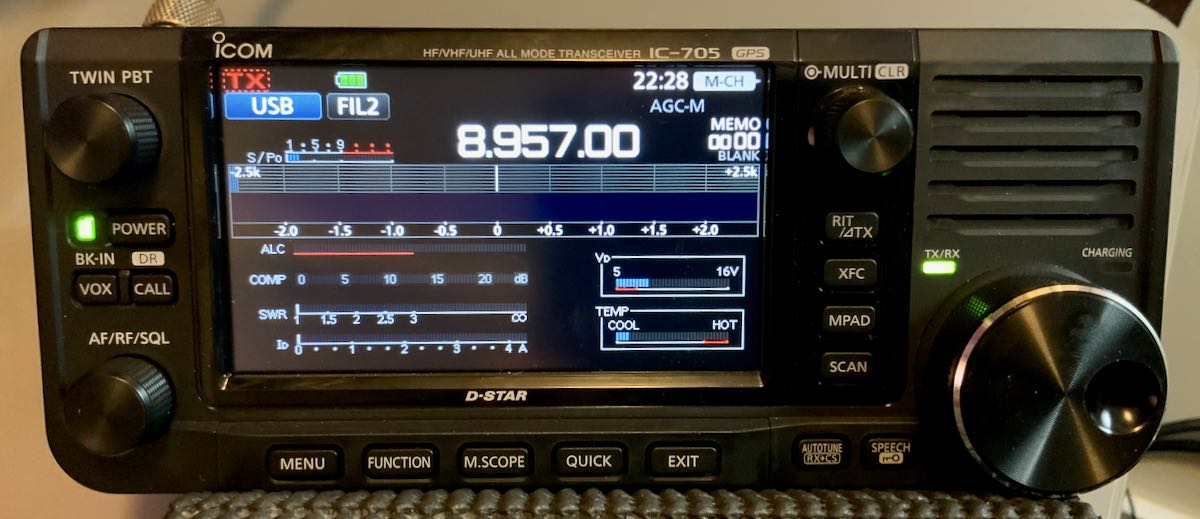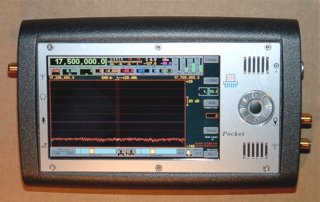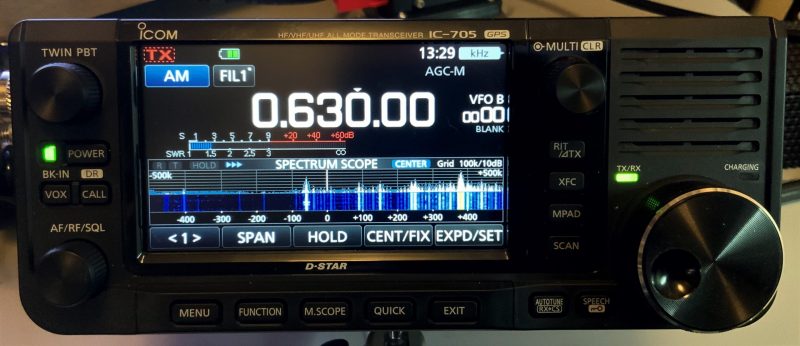 Many thanks to SWLing Post contributor, Uli (DB1ULI), who writes:
Many thanks to SWLing Post contributor, Uli (DB1ULI), who writes:
Hello Thomas,
I started to enjoy BCL and SWL some week ago (again). I have a HAM license for many years, but was QRT for the past few years. Now, the HAM bug bit somehow again and I’ve been listening to the bands via a Tecsun H-501 but changed this one to a Reuter Pocket already.
The Pocket is a really great receiver including also the FM Bands and the popular (in Europe) Digital Broadcasting DAB.
Still, it is just a receiver. So for now I am searching for a new rig, too. The current offerings are all tempting, FT-DX 10, FT-991A, IC-7300, IC-705 and so on. I really like the new models due to their features, and most due to their displays. My former rig was a Yaesu FT-897.
I already read your and the other reviews of the IC-705 (especially the BC receiving parts) and it could replace the Reuter in many ways. I am just a little bit reluctant because I like the longwave band a lot (we still have stations here) and there is no info to find anywhere how it works below 500kHz. MW seems to be on par with most other receivers.
Do you have an idea about a source of information concerning the capabilities of the IC-705 below 500kHz?
All the best and 73,
Uli
Great question, Uli. I’m hoping that some of our European IC-705 owners may be able to help you here. Although I’ve spent a lot of time on mediumwave with the IC-705, I’ve done little exploring of longwave.
Please comment if you have thoughts on the IC-705’s longwave performance!



Hi all,
many thanks for your comments and tests. I really appreciate it. I pulled the trigger now for an IC-705 which is expected to find its way to me next week. I purchased an antenna switch in addition to do a side by side comparison with my Reuter Pocket. My current antenna is a PA0RDT Mini Whip which works very well on the lower frequencies. I will report about my observations then. But I guess the IC-705 will stay anyway. There are such a lot features I always missed as a HAM some years ago with the oder rigs. They where always way behind the technology. With the IC-705 Icom made some steps forward in this regard.
73,
Uli
DK4ZU (ex DB1ULI)
I see a lot of mention about MW and LW built in attenuation… but no mention of the user selectable pre amp. The attenuation is not a problem
My best receiver for LW is a ’60 Murphy B842, followed by an ITT Tiny 109 and by Grundig Satellit 2100. These receivers have a very long ferrite an no lowpass filter. Good performance also by Kenwood R-600.
Hi Uli,
Like I wrote under “Sensitivity” here…
https://swling.com/blog/2021/06/the-icom-ic-705-is-this-really-a-new-holy-grail-swl-bcl-receiver/
…the MW/LW bandpass (or lowpass) kicks in at 1600 kHz and there is only a minuscule signal loss below (link to AB4OJ’s RW measurements is in the article). There is no further difference between 1500 kHz and 50 kHz. By coincidence I have an unused bandscan video on YT with the first minute tuning through LW and the NDB band – the comparatively lower signals down there come from the vertical monopole I used that day, possibly the worst kind of antenna for frequencies < 500 kHz.
Hi 13dka,
thanks for this interesting video. I will do a side by side with the Reuter Pocket as soon the IC-705 has arrived. But it is likely that I do not have to worry about sensitivity. The 705 has a 10kHz bandwith filter for AM as far I have read in the manual, which should be quite sufficient. The Reuter Pocket has broader filters up to 20kHz at the time base demodulation AM mode. For stronger stations 12kHz and sometimes even 14kHz improve the fidelity quite a bit. But as soon the stations are weaker, 10kHz and less is OK.
All the best,
Uli
The 7300 has a hard-to-find menu-selectable MF “Band Attenuator”. I would assume that the 705 has the same. I don’t remember if the factory preset is on or off
For this request I have connected my IC-705 to my active receiving antenna. Normally I use this antenna with an RSP1.
* You can tune the IC-705 down to 30 kHz. Then it switches to 70 cm. So forget SAQ.
* Above 200 kHz I have lots of QRM, probably my own ADSL line.
*Below 200 kHz the IC-705 behaved as I know it from the RSP1 SDR, but I made no 1:1 tests.
Here in central Europe we have a few strong transmitters in the 128-139 kHz range. On 77.5 kHz there is DCF77, our time signal transmitter. All were strong and clear.
But I never tried to listen to the ham bands there.
Hi Alexander,
thanks for the test and the information. I have fortunately only modest QRM on LW and MW. My Mini Whip it at 6m in my garden, 15m away from any buildings. This seems to be far enough from local QRM sources.
73,
Uli
DK5ZU
According to the official ICOM specifications, the IC-705 has an AM sensitivity of 13.0 ?V (for 0.5 ~ 1.799999 MHz). My (older) Icom IC-7600 has an AM sensitivity of 6.3 µV (for 0.1–1.799 MHz) and is practically useless under 1.6MHz!
When my amplified Wellbrook loop antenna (ALA1530LN) is connected it to my IC-7600, it does not receive the Droitwich transmitter of “BBC Radio 4” on 198kHz at all, absolutely nothing! while my trusty JRC NRD-525 receive it with S9! So I guess what N7MSD wrote is unfortunately correct, they do attenuate the MF & LF bands!
Vy 73 de HB9EVW
@HB9EVW: Our distance to Droitwich is about the same and the direction not so different.
The reception of 198 kHz is poor during daylight. During the night I can understand most of what is said using my IC-705.
Especially with an active antenna the receiver sensitivity is no real problem, but large-signal reception is.
I’ve owned the 705 for about six months now; LF NDB DXing is a primary radio listening interest. I agree with Nick’s comment–the 705 is as good at LF as any of my other radios that I use for LF (R75, AOR 7030).
Steve AA7U
I have had a 705 for a couple years now. I am not a Ham and only use it as a receiver. In the US we really don’t have much on Longwave except for NDB’s and the 60 khz WWV CW signal. I can say that with the same antenna the 705 will bring in anything any of my radios. can bring in. I use a Wellbrook and the NDB’s and the 60khz signal come in great. It is also awesome to be able to see the really weak NDB’s on the spectrum scope. The 705 is a great LW receiver and I highly recommend it. You can see some of my receivers and the 705 on my youtube channel if you are interested, my name there is “dieselten01”. Here is a direct link to a bandscan during a power outage, using just s longwire for an antenna. No power available for the Wellbrook https://youtu.be/4NimabeZuvE
My understanding (albeit anecdotal to this point) is that the new Yaesu radios, FTDX-101D and, the more affordable FTDX-10, have excellent reception in these ranges. Might be worth looking into at least. Cheers! (And welcome back to the amateur bands, Uli!)
Uli probably doesn’t realize that we now have amateur MF & LF bands now (137 & 475 KHz). For those & NDBs and probably more, I am *VERY* interested in this answer as well, as well as for comparable transceivers like Xiegu, the Radioddity QR20, etc.
However, I’m afraid I already know: Icom (and many others I think) put high pass filters to keep out AM MW broadcast, and by definition LW & down is attenuated as well; this is done to try preventing overload / intermod. I know because mods have been posted to remove the filters but I don’t remember for the 705.
Thanks in advance also!